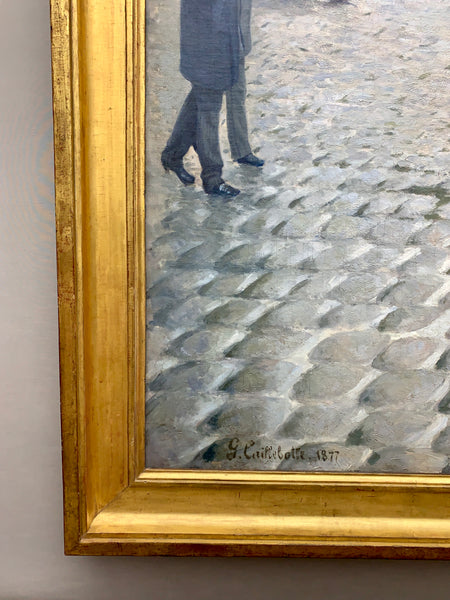I am here for a week in Berlin, Germany. Wanting to see if they got any new work in the Alte Nationalgalerie I was delighted to find a temporary exhibition of Gustave Caillebotte: Painter and Patron of Impressionism. The showpiece of the exhibition is Caillebotte painting “Paris Street; Rainy Day” (“Rue de Paris, temps de pluie”), completed in 1877 and now an icon of Impressionism, borrowed from the Art Institute of Chicago. It takes up the most prominent place in the room: the far end you face on from several rooms ahead as you walk through the gallery.

Although surrounded my Impressionist masters’ less know pieces, the painting dominates the room. It grabs you quickly, not just because of its iconic look, but because of its sheer size. At 2.39 m x 1.85 m, it is so much more than what I had expected: a little impressionist piece. Taking up the better part of the wall, it is at a life-size when you’re approximately 6m away from it. Up close, it is larger than life and not unlike Monet’s immense waterlilies, it swallows the viewer up in its watery essence.
From the distance, the painting looks much “tidier” than any other Impressionist work you’d imagine. The shapes looks clear, the contrast deep and the brushwork indiscernible. The iconic umbrellas are sharp and tight, reflecting the overcast of the rain clouds. The smooth surfaces of the Paris cobblestone are even more reflective with rain and while walking towards the painting, you can’t help but feel slippery underneath your feet, like a dog paddling above a bucket of water. There is a calculated attempt to transport you into the scene.

Looking up closely, the freedom of the Impressionist principles reveal themselves: the brush movements are Short and hectic, the use of colour varied despite the cold, muted overall palette, and there is no realism left in the details. It feels like Caillebotte married two different sentiments and left to the viewer to decide which one they’ll enjoy more.

Not done challenging my foolish expectations of an Impressionist painting, the room behind the work reveals its secrets: the carefully planned composition, the half dozen of sketches of the background characters, the studies of umbrellas and analysis of the street perspective. Caillebote gives us a snapshot of a day, but he’s obviously spent months carefully crafting it.
Speaking of a snapshot, the painting seems to be lending its reality as if from a photograph. None of the figures are “posing”, their gesture insinuating a rush to get away from the rain. The main figures closest to us are taking up the sidewalk, and the incoming man who is cut out of the foreground on the right seems to be doing the tilting of the umbrella when we avoid strangers’ umbrellas.
The takeout
I find myself impressed with the figures in the foreground. Their gaze seems to follow something happening across the street, and if we were walking towards them from the point of viewer, they are undoubtedly about look towards us. This is a brilliant way to pull the viewer in without a direct gaze. Sounds like a sneaky marketing psychology trick, but aren’t you just looking at the space next to them on the sidewalk, wondering will you be able to walk through?
Another thing I admire are their clothes. Although out of focus, I am amazed at the front figures’ clothes. It is amazing how well you can sense there are layers upon layers of Victorian era underskirts and blouses below the heavy top layers on the female figure, without even one sharp line showing. Her forward stepping leg creases the skirt just so, and then her hand holds the supposed rim out of water’s way below. It’s a brilliant, everyday moment that we don’t see nowadays yet we understand it. I’m keen to learn to show such delicate moments in my own clothed figure work.
The fact that this oil painting looks as delicate as a watercolour gives me ideas on how to use the heavier paints without over-saturating the work. Caillebotte’s piece is as if lit up from within: something I’d go about achieving with light washes of pigment over a white paper. Yet here he is, layering different tints and values of light upon light, the umbrella upon a light building upon the backlit sky, and they still hold together. The pieces of unlit surfaces, the window sills, the lamp post and puddles between cobble stones appear in just enough quantity to give tonal scaffolding for the blinding daytime outpour of light.
This careful, yet risky balance of the painting encourages me to experiment with different styles in one piece, to follow the classic, academic rules but implement them with some new choices and - keep myself open to the outcome.

